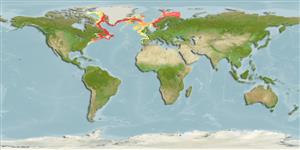Teleostei (teleosts) >
Perciformes/Zoarcoidei (Eelpouts and pricklebacks) >
Zoarcidae (Eelpouts) > Lycodinae
Etymology: Lycodes: Greek, lykos = wolf + Greek, suffix, oides = similar to (Ref. 45335).
Environment: milieu / climate zone / depth range / distribution range
Ecology
Marine; bathydemersal; depth range 143 - 1090 m (Ref. 117245), usually 240 - 619 m (Ref. 117245). Deep-water; 76°N - 36°N, 76°W - 36°E (Ref. 117245)
North Atlantic: Nunavut (Ref. 58426), western Barents Sea to southern Norway, the Faeroes-Shetlands and northern Iceland.
Size / Weight / Age
Maturity: Lm ? range ? - ? cm
Max length : 75.0 cm TL male/unsexed; (Ref. 4695); common length : 47.5 cm TL male/unsexed; (Ref. 4695)
Occurs at a temperature range of -0.4° to 5.6 °C (Ref. 117245). Optimal temperatures appear to range between 2.6° and 3.5°C. Inhabits soft bottom areas (Ref. 13532). Benthic (Ref. 58426). Feeds almost exclusively on ophiuroids (Ref. 13532).
Life cycle and mating behavior
Maturities | Reproduction | Spawnings | Egg(s) | Fecundities | Larvae
Andriashev, A.P., 1986. Zoarcidae. p. 1130-1150. In P.J.P. Whitehead, M.-L. Bauchot, J.-C. Hureau, J. Nielsen and E. Tortonese (eds.) Fishes of the North-eastern Atlantic and the Mediterranean. volume 3. UNESCO, Paris. (Ref. 4695)
IUCN Red List Status (Ref. 130435)
Threat to humans
Harmless
Human uses
Tools
Special reports
Download XML
Internet sources
Estimates based on models
Preferred temperature (Ref.
123201): 1.1 - 5.4, mean 3.2 °C (based on 330 cells).
Phylogenetic diversity index (Ref.
82804): PD
50 = 0.5000 [Uniqueness, from 0.5 = low to 2.0 = high].
Bayesian length-weight: a=0.00224 (0.00139 - 0.00361), b=3.22 (3.08 - 3.36), in cm total length, based on LWR estimates for this species & Genus-body shape (Ref.
93245).
Trophic level (Ref.
69278): 3.9 ±0.56 se; based on food items.
Resilience (Ref.
120179): Very Low, minimum population doubling time more than 14 years (Preliminary K or Fecundity.).
Fishing Vulnerability (Ref.
59153): Moderate to high vulnerability (50 of 100).
Nutrients (Ref.
124155): Calcium = 18.4 [9.8, 38.2] mg/100g; Iron = 0.33 [0.17, 0.64] mg/100g; Protein = 16.8 [14.0, 19.0] %; Omega3 = 0.238 [0.122, 0.463] g/100g; Selenium = 23.8 [9.5, 61.0] μg/100g; VitaminA = 9.9 [2.1, 48.4] μg/100g; Zinc = 0.385 [0.255, 0.592] mg/100g (wet weight);
